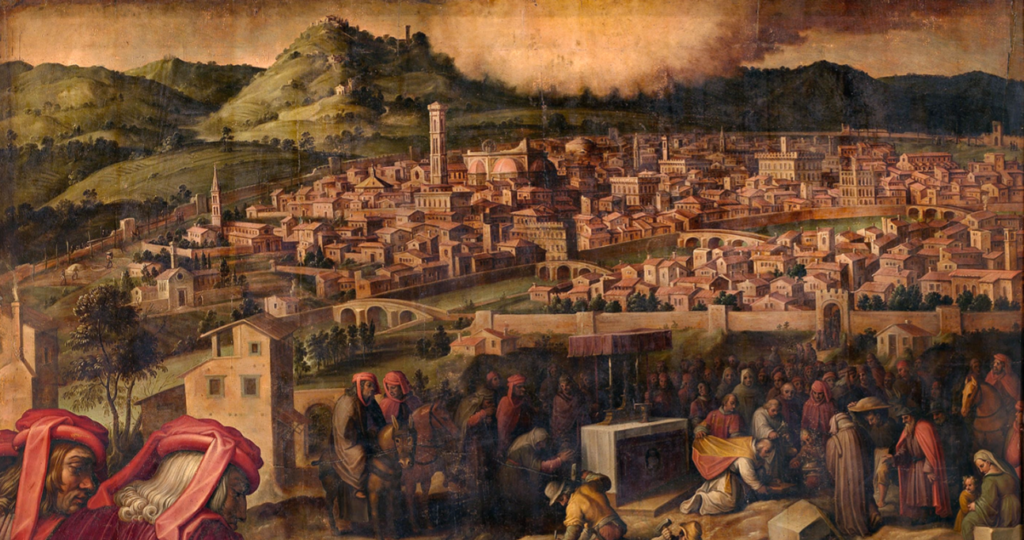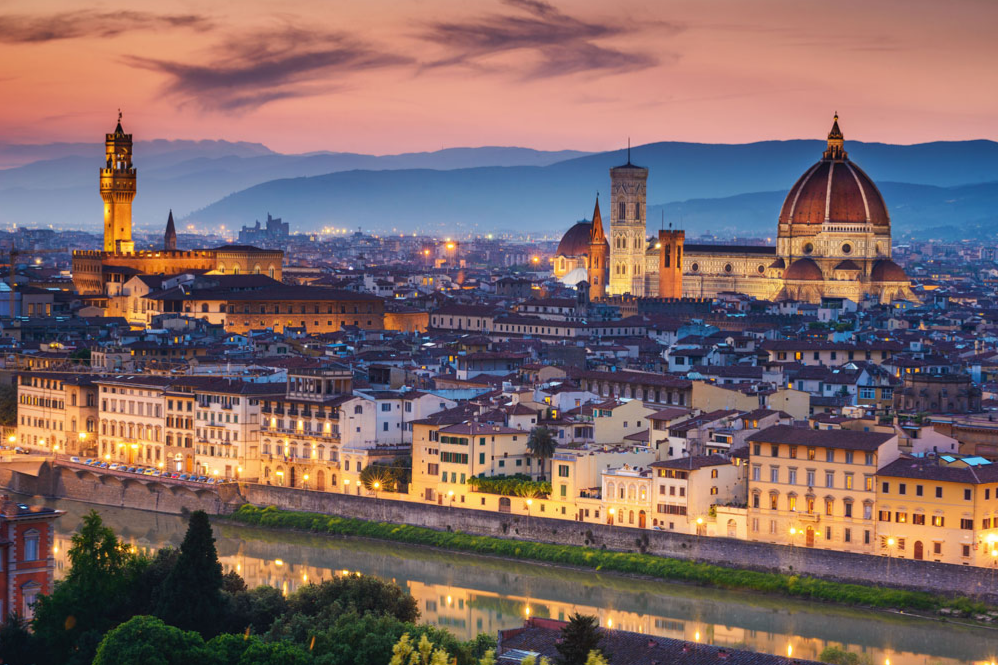Florence, Italy: Renaissance Art and Architecture
Florence, the capital of Italy’s Tuscany region, is widely recognized as the birthplace of the Renaissance. This historic city is an open-air museum of art and architecture, boasting masterpieces created by some of the greatest minds in history, including Michelangelo, Leonardo da Vinci, and Brunelleschi. Florence’s narrow cobblestone streets, majestic cathedrals, and world-class museums make it a dream destination for art lovers, history enthusiasts, and travelers seeking to immerse themselves in a city steeped in culture and beauty. From the iconic Duomo to the treasures of the Uffizi Gallery, Florence offers a journey through one of the most remarkable periods in human history.

The Renaissance in Florence: A Historical Overview
The Renaissance, which means “rebirth,” was a cultural movement that began in Florence during the 14th century and spread across Europe over the following centuries. Florence’s wealth, largely derived from banking and trade, allowed the city to become a patron of the arts and a hub for intellectual and cultural development.
Under the guidance of influential families such as the Medici, Florence flourished as artists, architects, and scholars transformed the city into a center of innovation and creativity. The Renaissance emphasized the revival of classical ideals, humanism, and the pursuit of beauty, themes that are evident in Florence’s art and architecture to this day.

Florence’s Iconic Architecture
Florence’s skyline is defined by its stunning architecture, much of which was created during the Renaissance. From grand cathedrals to elegant palaces, the city’s buildings are a testament to the artistic vision and technical skill of its architects.
The Florence Cathedral (Il Duomo)
The Cathedral of Santa Maria del Fiore, known simply as the Duomo, is Florence’s most iconic landmark. Its massive red-tiled dome, designed by Filippo Brunelleschi, dominates the cityscape and is considered one of the greatest engineering achievements of the Renaissance.
Visitors can climb to the top of the dome for breathtaking views of Florence and the surrounding Tuscan countryside. Inside the cathedral, the frescoes by Giorgio Vasari and Federico Zuccari depict the Last Judgment, offering a vivid glimpse into Renaissance artistry.
Adjacent to the cathedral, the Giotto’s Campanile (bell tower) and the Baptistery of San Giovanni, with its intricate bronze doors known as the Gates of Paradise, complete the architectural ensemble of Piazza del Duomo.

Palazzo Vecchio
The Palazzo Vecchio, Florence’s historic town hall, is a fortress-like structure that has served as a symbol of political power for centuries. Its grand interiors are adorned with frescoes and sculptures, including works by Michelangelo and Donatello. Visitors can explore the Hall of the Five Hundred, a vast chamber filled with Renaissance artwork, or climb the tower for panoramic views of the city.

Basilica of Santa Croce
Known as the “Temple of Italian Glories,” the Basilica of Santa Croce is the final resting place of many of Florence’s most illustrious figures, including Michelangelo, Galileo Galilei, and Niccolò Machiavelli. The church is also home to beautiful frescoes by Giotto and a stunning marble façade.

Ponte Vecchio
The Ponte Vecchio, Florence’s most famous bridge, is a medieval structure lined with shops that sell jewelry, art, and souvenirs. Spanning the Arno River, the bridge is an iconic symbol of Florence and a romantic spot to watch the sunset.
Masterpieces of Renaissance Art
Florence is home to some of the world’s most celebrated art collections, showcasing works by Renaissance masters that continue to inspire awe and admiration.

The Uffizi Gallery
The Uffizi Gallery is one of the most renowned art museums in the world, housing a vast collection of masterpieces from the Renaissance. Highlights include:
- The Birth of Venus by Sandro Botticelli: A luminous depiction of the goddess Venus emerging from the sea on a shell.
- Primavera by Botticelli: An allegorical celebration of spring, filled with intricate symbolism.
- Annunciation by Leonardo da Vinci: A delicate portrayal of the Angel Gabriel announcing to Mary that she will bear the son of God.
- Medusa by Caravaggio: A dramatic and haunting interpretation of the mythological figure.
The museum’s corridors are adorned with classical sculptures and offer views of the Arno River, providing a visual feast for art lovers.
The Accademia Gallery
The Accademia Gallery is best known as the home of Michelangelo’s David, one of the most famous sculptures in the world. Carved from a single block of marble, David represents the biblical hero who defeated Goliath, symbolizing strength and determination. The museum also features other works by Michelangelo, including his Prisoners, as well as a collection of Renaissance paintings and musical instruments.
The Bargello Museum
The Bargello Museum is a treasure trove of Renaissance sculpture, featuring works by Donatello, Michelangelo, and Gian Lorenzo Bernini. Donatello’s bronze David, a groundbreaking depiction of the biblical hero, is one of the museum’s highlights.
Frescoes and Religious Art
Florence’s churches and chapels are filled with exquisite frescoes that reflect the artistic genius of the Renaissance. Notable examples include:
- The Brancacci Chapel in the Church of Santa Maria del Carmine, with frescoes by Masaccio and Masolino.
- The San Marco Monastery, where Fra Angelico’s frescoes adorn the walls of the monks’ cells, offering a serene and spiritual experience.
Exploring Florence’s Streets and Piazzas
Florence’s streets and piazzas are as enchanting as its museums and monuments. Walking through the city is like stepping into a living Renaissance painting.

Piazza della Signoria
The Piazza della Signoria is Florence’s political and cultural heart. Dominated by the Palazzo Vecchio, the square is adorned with statues, including a replica of Michelangelo’s David and the Fountain of Neptune by Bartolomeo Ammannati. The Loggia dei Lanzi, an open-air gallery, displays classical sculptures, including Perseus with the Head of Medusa by Benvenuto Cellini.
Piazza Santo Spirito
Located in the Oltrarno district, Piazza Santo Spirito is a lively square surrounded by cafes, restaurants, and artisan workshops. The Basilica of Santo Spirito, designed by Brunelleschi, is a hidden gem with a tranquil atmosphere.
Florence’s culinary scene reflects its Tuscan heritage, with an emphasis on fresh, local ingredients and traditional recipes.
- Bistecca alla Fiorentina: A thick, juicy T-bone steak grilled to perfection.
- Pappa al Pomodoro: A hearty tomato and bread soup flavored with olive oil and basil.
- Ribollita: A traditional vegetable and bread stew.
- Gelato: Florence is the birthplace of gelato, and the city offers countless gelaterias serving flavors from classic pistachio to innovative combinations.
Pair these dishes with a glass of Chianti wine, produced in the nearby Tuscan countryside, for a true taste of Florence.
Practical Tips for Visiting Florence
- Best Time to Visit: Spring (April to June) and autumn (September to October) offer pleasant weather and fewer crowds.
- Getting Around: Florence is a walkable city, and most major attractions are within easy reach. Bicycles and public buses are also available for exploring further afield.
- Accommodations: From luxury hotels overlooking the Arno River to charming guesthouses in historic buildings, Florence offers a range of accommodations to suit all budgets.
Why Florence Captivates Visitors
Florence is a city that captures the essence of the Renaissance, offering a journey through art, history, and culture unlike any other. Its magnificent architecture, world-class museums, and vibrant streets create an atmosphere of timeless beauty and inspiration.
Whether you’re marveling at Michelangelo’s David, wandering through the Uffizi Gallery, or savoring a meal in a cozy trattoria, Florence promises experiences that will linger in your memory. For travelers seeking to immerse themselves in the treasures of the past while enjoying the charm of modern Italy, Florence is an unparalleled destination.
